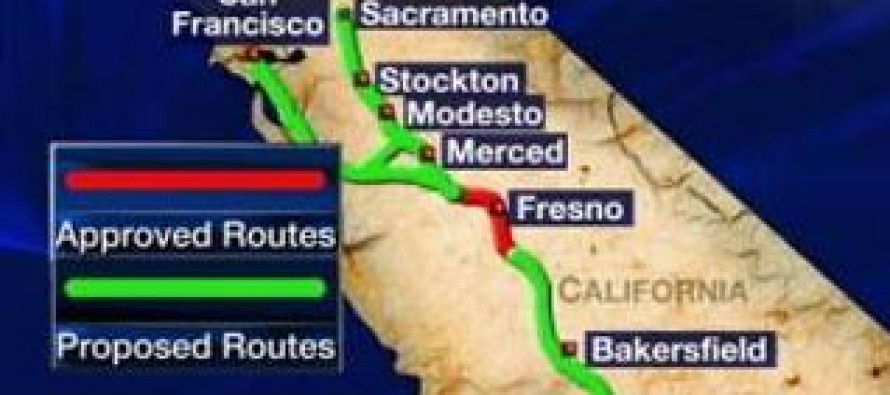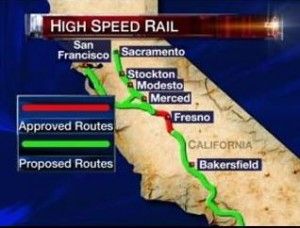High-speed rail takes two more swipes at CEQA

This is the second in a series of articles updating the status of the California high-speed rail project in the wake of the California Supreme Court green-lighting bond funding. The first article covered two earlier attempts by the California High-Speed Rail Authority to get around the California Environmental Quality Act. This article covers two more attempts.

In his 2013 State of the State address, Gov. Jerry Brown quoted “The Little Engine That Could”: “I think I can. I think I can.”
One thing the California High-Speed Rail Authority, which runs the project, thinks it can do is get around the California Environmental Quality Act. As noted in the first article in this series, it started with two attempts:
- Attempt 1: During the California Legislature’s closing days in August 2012, the CHSRA tried to pass more lenient measures to comply with CEQA. The Legislature didn’t cooperate.
- Attempt 2: In June 2013, the CHSRA filed a request with the 3rd District Court of Appeal in the city of Atherton’s suit against the project. The CHSRA wanted the court to recognize the federal pre-emption of jurisdiction, getting around state laws, such as CEQA. The court refused.
Attempt 3
Attempt 3: De-publication. Now, in its third attempt to get around CEQA, on Sept. 22 California Attorney General Kamala Harris asked the California Supreme Court for the de-publication of the 3rd District’s decision in the Atherton case. If granted, it would have meant future cases would have been restricted in using this case for precedent. Harris is representing the CHSRA.
Basically, what Harris and the CHSRA said was that, regardless of the language in Proposition 1A in 2008, they instead wanted to put the project into federal jurisdiction. And that, any interpretation to the contrary, such as that by the 3rd District Court of Appeal, had “misinterpreted” those facts, and ought to be de-published.
De-publication would have offered a quick way to minimize the damage of the 3rd District Court of Appeal’s decision. If the Supreme Court had agreed to de-publish the decision, it would have blocked that decision from being used as a precedent for other cases.
Stuart Flashman, an attorney for Kings County and two residents who have brought suit to stop the project, filed a brief against the de-publication, arguing:
“If the Attorney General wished to press these points, her proper recourse was to petition for review, and the other agencies could have supported review….
“If the parties seeking de-publication feel that major state transportation projects should not be subject to CEQA review, that argument should be addressed to the Legislature, which clearly knows how to exempt classes of projects from CEQA review when it feels such exemption is warranted.”
On Oct. 29, the Supreme Court denied the de-publication request. Therefore, the 3rd District Court of Appeal’s decision is now final and conclusive.
Attempt 4
Attempt 4: the Surface Transportation Board. Private attorneys Nossaman LLP have a $17 million contract to represent the CHSRA. An Oct. 9 petition by Nossaman asked for declaratory relief, that is, an official declaration of the status of a matter in controversy to expedite a court case.
In this case, the CHSRA is specifically asking the STB to take off the table any request for a injunction against construction for any party suing under CEQA. The CHSRA want federal laws to preempt state laws.
(The STB is a federal agency under the Department of Transportation. A year ago, on Dec. 3, 2013, the STB declared it held federal jurisdiction because California’s tracks would also be used by Amtrak; and the tracks cross state lines.)
The CHSRA wants to prevent the chance of a construction injunction being granted for a Central Valley case represented by Attorney Doug Carstens from Chatten-Brown & Carstens LLP. He represents Kings County, Citizens for High Speed Rail Accountability and the Kings County Farm Bureau.
The reason his clients are suing is because of alleged CEQA improprieties in the Fresno-to-Bakersfield segment. The CHSRA said that, if the injunction was granted, it could endanger the start of building the high-speed rail system; and the CHSRA has a tight time frame on the use of $3.5 billion in federal funds.
But there is no emergency. The actual case is not expected to be heard until mid-summer 2015. Moreover, there are six other CEQA cases filed against the project and not one of them is ready to go to court this month.
A decision from the STB is expected soon. If the STB grants declaratory relief, basically preempting CEQA with a federal supremacy claim, the next step will be the U.S. 9th Circuit Court of Appeals.
Kathy Hamilton is the Ralph Nader of high-speed rail, continually uncovering hidden aspects of the project and revealing them to the public. She started writing in order to tell local communities how the project affects them and her reach grew statewide. She has written more than 225 articles on high-speed rail and attended hundreds of state and local meetings. She is a board member of the Community Coalition on High-Speed Rail; has testified at government hearings; has provided public testimony and court declarations on public records act requests; has given public testimony; and has provided transcripts for the validation of court cases.
Related Articles
Sacto Airport Another Vanity Project
April, 2, 2012 By, Katy Grimes SACRAMENTO – I’ve long mocked the Sacramento “International” Airport for not having any direct
Four New California Cities Might Dissolve
Editor’s Note: Correction Below MARCH 13, 2012 By WAYNE LUSVARDI Newspapers across the United States have told of the financial
Will dockworkers strike?
West Coast dockworkers are threatening to strike again from their incredibly high-paying jobs. Their members already earn $25 to $40



